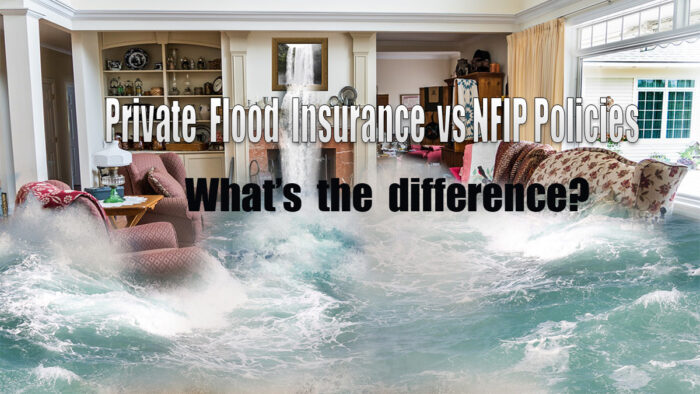In the process of safeguarding your property and home from damage, understanding the available options for flood insurance is very important. Flood insurance quotes are divided into two different types. We have private flood insurance and the National Flood Insurance Program [NFIP]. But what’s the difference between private flood insurance and NFIP?

Although both insurance policies are designed to offer protection against losses that are flood-related, there are significant differences between private flood insurance and NFIP policies. When it comes to term flexibility, coverage limits, availability, and pricing, we will see the clear and notable differences between private flood insurance and NFIP policies.
First of all, private flood insurance is an alternative that offers wide coverage options, flexible pricing, and higher coverage limits, designed to meet the needs of policyholders.
On the other hand, the NFIP was created to decrease the effect of flooding on public and private institutions by offering cheap insurance policies to property owners. They also advise communities to enforce and use floodplain management laws.
What is Private Flood Insurance?
As mentioned previously, private flood insurance is a flood insurance policy provided by private insurance companies, unlike policies offered and managed by the Federal Emergency Management Agency (FEMA). Unlike back in the day, the private flood insurance market has grown and offers alternative options for flood coverage to homeowners and businesses.
Even though the coverage options of private flood insurance are similar to those of the National Flood Insurance Program, there are still some differences between them.
Now, let’s learn what private flood insurance covers.
What Does Private Flood Insurance Cover?
Private flood insurance typically offers coverage against damage caused by floods. In addition to this, the coverage options of a private flood insurance policy differ among lenders. But here is a general overview of what private flood insurance covers:
- Personal property.
- Temporary living expenses.
- Detached structures.
- Building property.
- Debris removal.
These are the situations that private flood insurance will offer coverage for, as long as it is included in your policy.
What Does It Not Cover?
Here is what a private flood insurance quote generally does not cover:
- Living expenses.
- Earth movement.
- Financial losses.
- Mildew, mold, and moisture damage.
- Outdoor property.
- Currency, and valuable papers and metals.
This is proof that you must review your flood insurance policy before purchasing it because it differs between insurance providers.
What is NFIP?
The NFIP, also known as the National Flood Insurance Program, is a program put together by the United States Congress. What’s more, it was established in 1968 through the National Flood Insurance Act.
Apart from this, it is controlled by the Federal Emergency Management Agency (FEMA). To repeat, they work to reduce the effect of flooding on public and private structures by giving affordable insurance coverage to renters, property owners, and businesses.
What Does the National Flood Insurance Program Cover?
The National Flood Insurance Program offers two main coverage options. This includes building coverage and content coverage.
For a better understanding, here is what the National Flood Insurance Program generally covers:
- Microwaves and dishwashers.
- The structure of your building or home.
- Debris removal.
- Window air conditioners.
- Washers and dryers.
- Original artwork and furs.
- Electronic equipment.
- Detached garages.
What is Not Part of Its Coverage?
These are situations or events that are not covered by the National Flood Insurance Program:
- Financial losses.
- Self-propelled vehicles.
- Earth movement.
- Precious metals, valuable papers, and currency.
- Mold, mildew, and moisture damage.
- Personal belongings and property outside the insured building.
- Living expenses.
However, both the building coverage and the content coverage are not included together. In other words, you will have to buy them differently.
Private Flood Insurance vs. NFIP: What’s the Difference?
The major difference between private flood insurance and NFIP is that private flood insurance offered by private insurers typically provides more comprehensive coverage options and personalized service compared to NFIP policies.
NFIP policies, managed by FEMA, have standardized rates and eligibility criteria. Private flood insurance may be more flexible in pricing and coverage, catering to specific property needs and risk assessments. This is a comprehensive overview of the distinctions between private flood insurance and NFIP policies in tabular form:
| Feature | Private Flood Insurance | NFIP Policies |
| Coverage Options | Wider coverage options | Standard coverage options |
| Coverage Limits | Can surpass $100,000 for contents and $250,000 for buildings | Maximum coverage for contents is $100,000, and for buildings, it is $250,000 |
| Pricing | Can be competitive | Determined by the government and differs between providers. |
| Availability | Private insurance companies | Communities taking part in the National Flood Insurance Program |
| Risk Assessment | Various risk management methods are used | FEMA flood maps |
| Claims Process | Faster claims process | Lengthy claims process |
| Mortgage Requirement | Required by most lenders | Required |
| Deductibles | Flexible | Standard |
| Policy Renewal | Renewal periods set by insurers | Renewal annually |
| Waiting Period | 14 days | 30 days |
Understanding the differences between private flood insurance and NFIP policies is important not just for homeowners but for businesses as well. For instance, it will help you make the right decisions that meet your financial security objectives and risk exposure. Hence, in the event of floods, you will be well protected.


